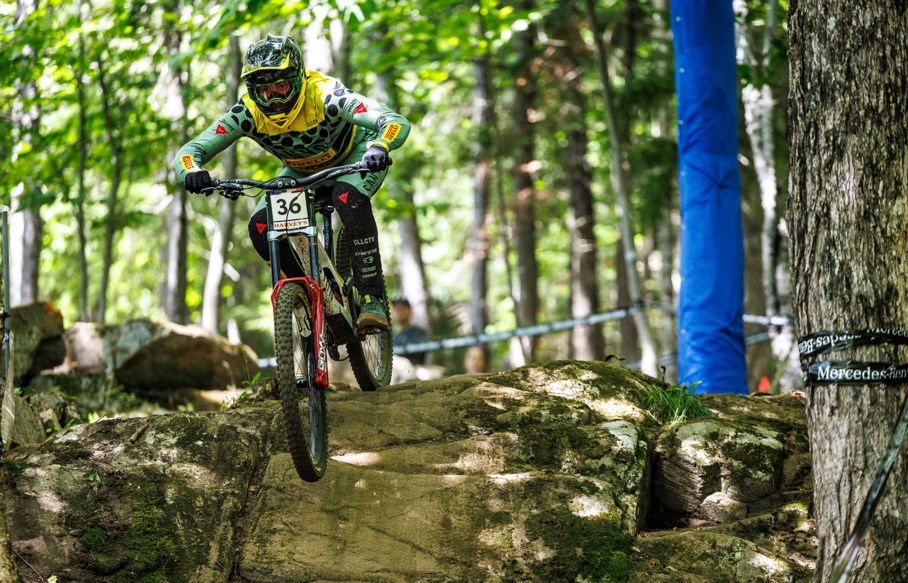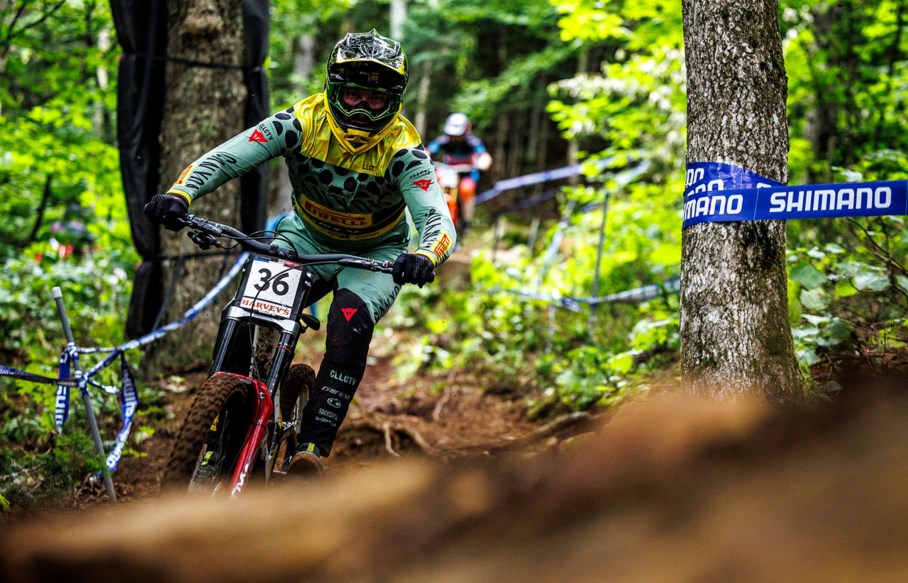PIONEERS
Loris Revelli about the first days of downhilling in San Romolo, Italy, and how he came to use Ochain

In 2025, you’ll find an Ochain on every other bike at a downhill World Cup. But, of course, someone had to be the first on the scene with the new product.
That person was Loris Revelli, one of Italy’s finest racing exports and a rider who has competed at the highest level, including finishing one place off a podium at the Mont-Sainte-Anne, Canada, World Cup in 2022. In his time using Ochain, he’s also won Italian National Championships and most recently, a round of the European Cup series.
Beyond his racing credentials, Revelli has always been an integral part of a vibrant riding scene. He grew up on San Romolo’s legendary downhill track in the north of the country and, like his father before him, now helps maintain the local riding scene while promoting next-generation riders.
We caught up with him between races.

The Daily Note: Loris, thanks for joining. Tell us a little about yourself.
Loris Revelli: I’m 27-years-old from Sanremo, Italy. I started riding in around 2010 and then in 2014 I started to race World Cups as a junior; I won a World Cup in Val di Sole in 2015. Then I moved to elite, had a couple of years as a privateer, or supported by some Italian teams. Next, I moved to Canyon, then Canyon-Pirelli for two years. And now I am racing and helping a new Italian team to work up through the ranks.
Have you always lived in Sanremo?
Yeah, I’ve always lived in Sanremo. And I think my passions come from there, because so many teams and people are coming to test bikes.
Can you tell us a bit about the heritage in Sanremo and San Romolo, the nearby village with a famous downhill track?
I was super young when my dad and Roberto Vernassa, my first team manager, made the track in San Romolo and started to organise an international race. I think I was six or seven when I first saw Sam Hill and Greg Minnaar, and I was hanging around with Loic Bruni and Loris Vergier, because their fathers were racing. I’ve seen so many people, so many bikes, from 26-inch, then 27, then 29. Later, I started to take care of the downhill tracks, and now I look after the tracks and the people that are coming here – teams and riders. There are many people riding now. It’s super nice to see them and see all the work paying off.
Can you describe the San Romolo track? If a bike doesn’t work, you know quickly that it doesn’t work there, right?
Yeah, we have two tracks. One is the most famous one, it’s the one from the top of the hill and it’s pretty long, like four and a half minutes. First part is super rocky and flat, and then it gets steeper and more technical. And if the bike doesn’t work, it’s even harder on the equipment – the wheels, everything – it’s very rocky. The second track is a little less rough with fewer rocks but it’s way faster, more like the new style of World Cup tracks. So now all the teams are switching a little bit – they do maybe a couple of days on the top track and then they move to the lower one, the newer one. But I’m building a new section on the top one to make it more World Cup-style again. So probably more and more brands will be coming again for testing.

How would you describe modern downhill World Cup tracks?
The tracks are getting way faster and rougher, I would say. Not in terms of technical skills, but with the people riding they get destroyed. I don’t think they’re technical anymore, not as much as a couple of years ago. But yeah, downhill is developing. Tracks are getting faster and faster. That’s what it is, and we have to adapt.
And would you say the skill and the setup is all about grip and, like you said, dealing with rough sections, noise, fine-tuning bikes?
Yeah, the margins are super tight. It’s all about also minimal details, bike setup, new technologies, finding the best grip. Everything matters.
You were one of the very first people using Ochain for racing. How did you find out about it and start using it?
I think I was in Maribor 2019 for an iXS Cup and I saw Fabrizio [Dragoni, the Ochain founder]. He had something on his chainring, and I saw his cranks moving. I was like, ‘whoa, what’s that?’ And he started to explain a little bit and I was like, ‘oh it would be nice to have it for Val di Sole World Cup’. Fabrizio gave me one for Val di Sole, so I was the first one to ride it. My qualifying didn’t go too well. I was doing well at the second or third split but then I had a flat, so I had to retire. But as a first ride with the Ochain, it was pretty good. And then a couple of days later I won the National Championships using it.
Can you describe the feeling using an Ochain?
It’s hard to explain. The bike feels way smoother – I feel like I have less input from the ground. My legs get less tired, so I can push more, and save some energy.
And then you’ve seen more and more people using the product as well, I’m sure.
Yeah. I think I would say it’s on 70% of the bikes in the World Cup.
I feel like I have less input from the ground. My legs get less tired, so I can push more, and save some energy.
What was it like then when you had it on your bike? Did people... Did other riders start saying, hey what’s that? How do I get one?
They saw my bike on Val di Sole. I think there was a picture on Pinkbike, I don’t remember. And then people the day after started asking and asking. I was like, ‘I don’t know what it is. But it works very well!’ And then they went to Fabrizio, and look how many people have it now.
Nice. What bikes do you use it on?
I have it on every bike. I have it on my V10, on my MegaTower, and on my Vala, on the e-bike. On the e-bike it’s insane.
For climbing?
For climbing, because the first pedal is less aggressive, it’s less aggressive so you can climb easier. And also, in the downhills it’s quieter.
That’s a nice advantage as well, right, the noise?
Yeah, very nice. And also, e-bike on the rough stuff... They’re super stable but on rough stuff they’re not working properly, and with [Ochain] it feels like butter over rocks. Especially where I live, it’s super rough. And I love to ride it on all my bikes.

Going on a tangent, if you close your eyes and imagine Italy, how would you describe it?
I would say, food first, because it’s pretty good. And people, they’re super friendly. Even if sometimes we are a bit shy, we are super friendly. And life is good, especially where I live. We have mountains, we have the sea in five minutes. So, life is good.
It seems like bikes are quite accepted where you live, mountain bikes, motorbikes?
Motorbikes, it’s big. We have three moto clubs, and I ride moto a lot. And I think we are around 300 people registered in the three clubs. And bikes, it’s getting bigger and bigger. We are not like Finale (Ligure, the popular mountain bike destination a little way east down the coast), because we don’t want to be [a big destination]. But also, the logistics is a little bit different than elsewhere, because the roads here are tight. E-bikes are now getting super popular.
You were talking about the Finale direction, but in the other direction you’ve got France, there’s a big mountain bike culture there and that’s always been part of San Romolo as well, right?
Yeah, exactly. I probably ride more with French people than Italians, because as I said before, I know Loic and Loris since we were kids. And near Nice and near my house there are probably like 20 riders that race World Cups. On Tuesdays I go to the BMX track in France and we’re all World Cup riders.
LORIS REVELLI BONUS QUESTIONS
Favourite rider: Loic Bruni
Pre-race music: Depends on the day
Free setup tip: Tyre pressure is very important. Tyres are the first place you get input from, the first thing that hits the ground. So check tyre pressures.